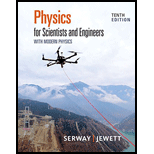
Concept explainers
(a)
To show: The energy associated with a single
(a)
Answer to Problem 23P
The energy associated with a single conducting sphere is
Explanation of Solution
Given info: The radii of two conducting sphere is
Write the expression to calculate the capacitance of a sphere of radius
Here,
Write the expression to calculate the potential difference.
Here,
Write the expression to calculate the energy stored in the capacitor.
Substitute
Conclusion:
Therefore, the energy associated with a single conducting sphere is
(b)
The total energy of the system of two spheres in term of
(b)
Answer to Problem 23P
The total energy of the system of two spheres in term of
Explanation of Solution
Given info: The radii of two conducting sphere is
Write the expression to calculate the capacitance of a sphere of radius
Write the expression to calculate the total energy of the system of two sphere.
Substitute
The sum of charge of both sphere are,
Substitute
Thus, the total energy of the system of two spheres in term of
Conclusion:
Therefore, the total energy of the system of two spheres in term of
(c)
The value of
(c)
Answer to Problem 23P
The value of
Explanation of Solution
Given info: The radii of two conducting sphere is
The total energy of the system of two spheres in term of
Differentiate the above equation with respect to
Conclusion:
Therefore, the value of
(d)
The value of
(d)
Answer to Problem 23P
The value of
Explanation of Solution
Given info: The radii of two conducting sphere is
The value of
The sum of charge of both sphere are,
Substitute
Conclusion:
Therefore, the value of
(e)
The potential of each sphere.
(e)
Answer to Problem 23P
The potential of each sphere is
Explanation of Solution
Given info: The radii of two conducting sphere is
Write the expression to calculate the potential of first sphere.
Substitute
Write the expression to calculate the potential of second sphere.
Substitute
Thus, the potential of each sphere is
Conclusion:
Therefore, the potential of each sphere is
(f)
The potential difference between the spheres.
(f)
Answer to Problem 23P
The potential difference between the spheres is zero.
Explanation of Solution
Given info: The radii of two conducting sphere is
The potential difference is,
Substitute
Conclusion:
Therefore, the potential difference between the spheres is zero.
Want to see more full solutions like this?
Chapter 25 Solutions
Physics for Scientists and Engineers with Modern Physics
- Lab 8 Part 3 PHET Wave Interface simulation. I am having trouble with this part of the lab.arrow_forwardMick and Rick are twins born on Earth in the year 2175. Rick grows up to be an Earth-bound robotics technician while Mick becomes an intergalactic astronaut. Mick leaves the Earth on his first space mission in the year 2200 and travels, according to his clock, for 10 years at a speed of 0.75c. Unfortunately, at this point in his journey, the structure of his ship undergoes mechanical breakdown and the ship explodes. How old is Rick when his brother dies?arrow_forwardHi, I have canceled, why did you charge me again?arrow_forward
 Physics for Scientists and Engineers: Foundations...PhysicsISBN:9781133939146Author:Katz, Debora M.Publisher:Cengage Learning
Physics for Scientists and Engineers: Foundations...PhysicsISBN:9781133939146Author:Katz, Debora M.Publisher:Cengage Learning Principles of Physics: A Calculus-Based TextPhysicsISBN:9781133104261Author:Raymond A. Serway, John W. JewettPublisher:Cengage Learning
Principles of Physics: A Calculus-Based TextPhysicsISBN:9781133104261Author:Raymond A. Serway, John W. JewettPublisher:Cengage Learning Physics for Scientists and EngineersPhysicsISBN:9781337553278Author:Raymond A. Serway, John W. JewettPublisher:Cengage Learning
Physics for Scientists and EngineersPhysicsISBN:9781337553278Author:Raymond A. Serway, John W. JewettPublisher:Cengage Learning Physics for Scientists and Engineers, Technology ...PhysicsISBN:9781305116399Author:Raymond A. Serway, John W. JewettPublisher:Cengage Learning
Physics for Scientists and Engineers, Technology ...PhysicsISBN:9781305116399Author:Raymond A. Serway, John W. JewettPublisher:Cengage Learning College PhysicsPhysicsISBN:9781285737027Author:Raymond A. Serway, Chris VuillePublisher:Cengage Learning
College PhysicsPhysicsISBN:9781285737027Author:Raymond A. Serway, Chris VuillePublisher:Cengage Learning Physics for Scientists and Engineers with Modern ...PhysicsISBN:9781337553292Author:Raymond A. Serway, John W. JewettPublisher:Cengage Learning
Physics for Scientists and Engineers with Modern ...PhysicsISBN:9781337553292Author:Raymond A. Serway, John W. JewettPublisher:Cengage Learning





